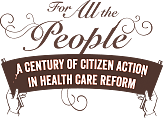Education Higher Education
Health Care Reform and History
Class 6: Health Care Reform in the 21st Century
Introduction:
In 2009, President Barack Obama declared, “I am not the first president to take up this cause [health care reform], but I am determined to be the last.” Obama did win a major victory with the passage of the Affordable Care Act (ACA) of 2010, the most sweeping and comprehensive health care reform in U.S. history. Based on changes to the private insurance industry and an “individual mandate” requiring most people to buy insurance, the ACA bears little resemblance to earlier health reform proposals. It is also mired in continuing controversy; although most of the law has been upheld by the Supreme Court in 2012 and 2015, opponents still argue for its repeal, and even supporters are uncertain how much access and affordability the ACA can guarantee.
Class Resources
Primary Sources
- Kaiser Family Foundation. “Summary of the Affordable Care Act.” Last modified April 25, 2013. http://kff.org/health-reform/fact-sheet/summary-of-the-affordable-care-act/.
- National Federation of Independent Business v. Sebelius, Secretary of Health and Human Services, 648 F. 3d 1235 (2012). Available online at https://www.law.cornell.edu/supremecourt/text/11-393.
- Obama, Barack. “Address to Congress on Health Care.” Speech to Congress, Washington, DC, September 9, 2009. YouTube video [starting at 2:30], 47:01, posted by The White House, September 10, 2009, https://www.youtube.com/watch?v=SSJugLUsM58; or Transcript online at https://millercenter.org/the-presidency/presidential-speeches/september-9-2009-address-congress-health-care.
Secondary Sources
- Starr, Paul. “Breaking Through, 2009–2010.” In Remedy and Reaction: The Peculiar American Struggle Over Health Care Reform. New Haven: Yale University Press, 2011, pp. 194–238.
Discussion Questions:
- Explain the shift away from universal coverage in 1993 (discussed in Class 5) toward health insurance reform in 2008–9. What kind of arguments did President Barack Obama use in his 2009 Address to Congress to argue for insurance reform? Compare Obama’s rhetoric to that used by Progressive reformers, FDR, Truman, JFK, LBJ, and Clinton.
- What did Obama learn from the defeat of the Clinton plan?
- How did partisan politics and interest group lobbying shape the final version of the Affordable Care Act?
- Why did the Supreme Court in NFIB v. Sebelius uphold the individual mandate but strike down the Medicaid expansion provision of the Affordable Care Act? What impact will the decision have on the implementation of the Act?
- Assuming you had the political support to do so, how would you redesign the American health care system?


